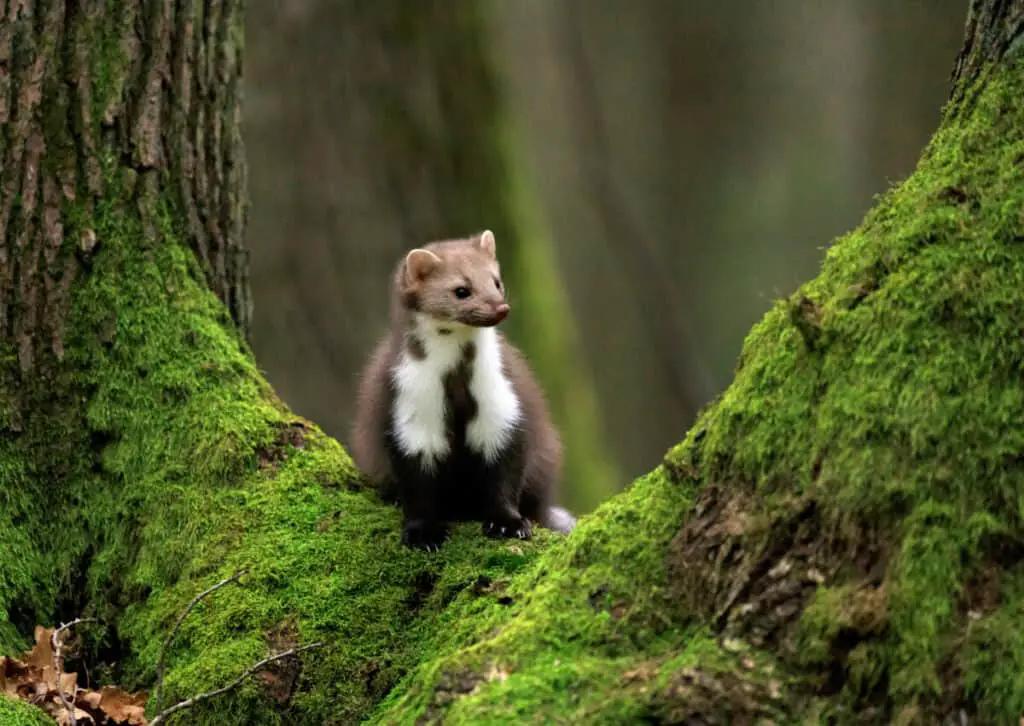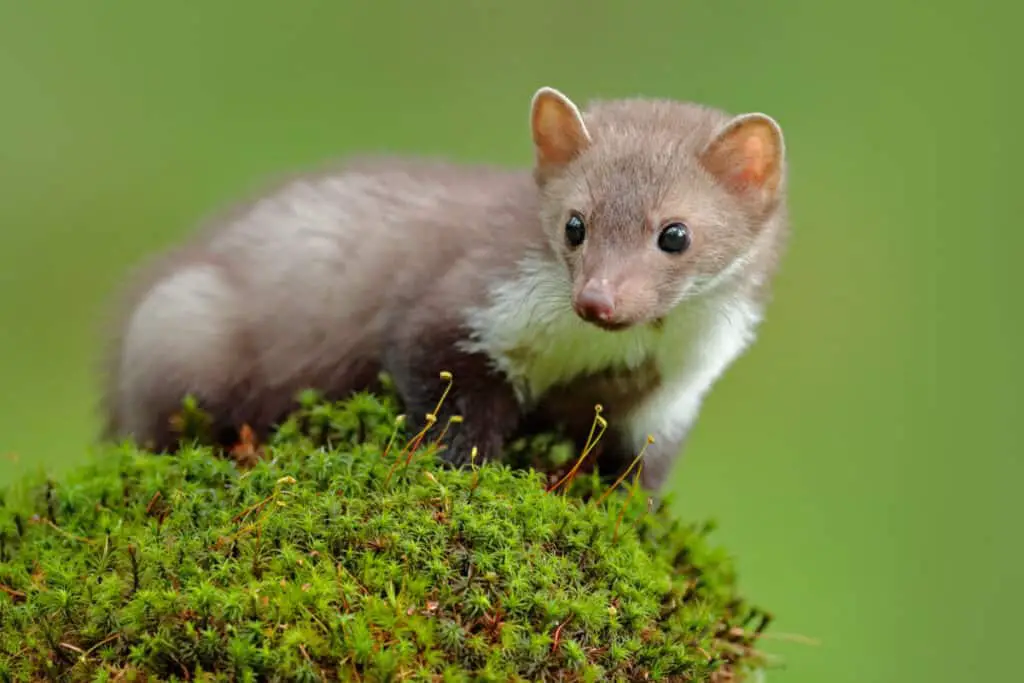Martens are a small mammal belonging to the Mustelidae family, which also includes mink, otters and badgers. They have short legs and long fur that can range in color from reddish-brown to black or silver.
The lifecycle of martens is complex and consists of several stages including birth, juvenile development and adulthood. This article will explore each stage of the marten lifecycle in detail, outlining how they survive and thrive in their natural habitats.
The typical life span for a marten ranges between two and four years; however, some individuals may live up to eight years. During this time they must contend with environmental factors such as food availability and predation risk while maintaining an appropriate body condition.
To do this successfully, martens rely on instinctive behaviors developed during different stages of their lives: birth through adulthood.

Birth And Early Development
Martens are small mammals that belong to the Mustelidae family and vary significantly in size, ranging from subspecies of domestic ferrets up to species such as fishers.
Marten lifecycles begin with birth and early development, which is subject to a variety of nesting habits that are largely dependent on location and climate.
Maternal care for martens typically includes building nests close to the ground out of foliage or grasses and providing nourishment until they reach independence at 8-10 weeks old.
As far as body mass is concerned, newborn kits usually weigh between 5 – 10 grams (0.18 – 0.35 oz) but quickly increase in weight over their first few months despite remaining reliant on their mother’s milk for nutrition during this period.
In addition, martens become more active by around 6 weeks old and start venturing away from their nest towards food sources, although still relying heavily on parental protection for safety.
How Big Are Martens: Exploring the Size of Agile Mustelids
Juvenile Development
Once martens reach their juvenile stage, they begin to explore the environment and exhibit different foraging behavior. For instance, by engaging in a nomadic lifestyle and constantly shifting habitats, these juveniles can locate new food sources that provide them with essential nutrients and energy.
Additionally, when selecting an area as their habitat, juveniles favor dense forest cover; this serves as protection from potential predators while also providing adequate shelter for survival.
Marten juveniles use their newfound independence to acquire skills necessary for adulthood. Through various methods of foraging such as hunting small rodents or scavenging carcasses left behind by larger mammals, young martens learn how to effectively hunt prey and recognize safe areas within their surroundings.
Furthermore, the ability to select suitable habitats is developed through trial and error as well as experience gained over time. This training enables them to become independent and develop into mature adults who are able to survive on their own without parental guidance.
Adulthood And Reproduction
Martens reach adulthood at around one year of age, when they are fully developed and capable of reproduction.
In the wild, mating rituals typically begin in late winter or early spring. Males will attempt to attract mates by releasing pheromones from their anal glands and marking trees with secretions from their chin glands. Females respond with a loud purring call that can be heard up to several miles away.
After mating is complete, females move into areas where there is ample cover for nesting habitat such as fallen logs, dense vegetation, and tree cavities. There she builds her nest out of grasses, leaves, and shredded bark lined with fur plucked from her own body.
The female marten then gives birth to 1-5 kits during the late spring months after a gestation period lasting about 10 weeks. She takes good care of them until they are ready to leave the den site at around 4-6 weeks of age. After this point they become independent and disperse into territories of their own.
Unveiling Marten’s Senses: A Fascinating Journey
Survival Strategies
Martens reach adulthood at the age of two. Reproduction usually takes place in the summer months, when adult martens will find a mate and establish a den to raise their young. Now that these animals are adults, they must focus on survival strategies for themselves and their offspring.
Habitat selection is an important strategy used by martens. They prefer dense woodland forests with piles of deadwood to use as homes or dens while living on the ground during warmer months and nesting off the ground in trees during colder months.
Martens also have winter adaptations such as thick fur coats that help them keep warm in cold weather. The coat helps reduce water loss from skin surfaces and keeps the animal’s temperature relatively stable even when temperatures drop below freezing point. This adaptation allows martens to survive harsh winter conditions which could otherwise be fatal if not adapted to properly.
Additionally, some species engage in hibernation during extreme cold periods as another means of surviving through difficult winters.
Overall, it is clear that habitat selection and winter adaptation play key roles in enabling marten species to survive into adulthood and reproduce successfully for future generations. These strategies ensure that this fascinating animal can continue its life cycle without interruption despite changes in climate or other environmental factors.
Unraveling Martens: Understanding Their Behavior

Life Span And Longevity
The life span of a marten is relatively short, with most individuals living for only three to four years in the wild. Yet despite their brief lives, these animals pack an incredible amount of energy and activity into such a small timeframe. Their swiftness and agility belie their size, allowing them to traverse through even the densest forests with ease.
Martens are highly dependent on their environment; they require suitable habitat selection which provides adequate food sources, safety from predators and access to mates. Dietary needs vary depending on location and season but generally consist of rodents, birds, eggs, fish and fruit. These adaptable mammals have been observed raiding beehives or harvesting crops as well when other food options become scarce.
They also play a key role in maintaining biodiversity by dispersing seeds across different habitats where they can germinate in more hospitable conditions:
- They create pathways between habitats through which seed-bearing fruits can travel
- Martens eat large amounts of fruit during autumn; this helps spread the seeds over wider areas
- The caching behaviour associated with martens aids in propagating new plants far away from their parent trees
- Thanks to its mobility, it has a significant impact on plant species composition throughout temperate deciduous forests
In spite of its diminutive stature, the presence of the marten within forest ecosystems carries great weight indeed. Its dietary habits help disperse many native plant species while providing essential nutrients for itself at the same time – ultimately serving as an important part of nature’s delicate balance.
Martens Revealed: Exploring Their Unique Characteristics
Conclusion
Martens have a unique lifecycle that plays an important role in the ecosystem. As they progress through their different stages of life, martens must adapt to their environment and develop strategies for survival.
From birth and early development all the way to adulthood and reproduction, martens are constantly evolving as they strive to reach old age. For example, adult marten females may produce up to four litters per year, each containing five or six offspring.
In order to ensure successful rearing of young, mothers store food during summer months and construct dens with multiple entrances to protect them from predators. With such adaptations, some marten populations can survive for decades or even centuries if conditions remain favorable.
Therefore, understanding the complex lifecycle of these furry creatures is essential for preserving healthy ecosystems worldwide.
